
Hoke County is a county in the U.S. state of North Carolina. As of the 2020 census, its population was 52,082. Its county seat is Raeford.
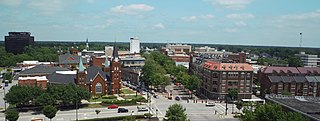
Fayetteville is a city in and the county seat of Cumberland County, North Carolina, United States. It is best known as the home of Fort Liberty, a major U.S. Army installation northwest of the city.

Spring Lake is a town in Cumberland County, North Carolina, United States. The 2010 census recorded the population at 11,964 people, with an estimated population in 2019 of 12,005.

The Market House is a market house and town hall in the center of Fayetteville, Cumberland County, North Carolina. It was built in 1838 on the site of the old state house and Town Hall which burned down in 1831. Fayetteville was the capital of North Carolina from 1789 to 1794.

This list includes properties and districts listed on the National Register of Historic Places in Cumberland County, North Carolina, United States. Click the "Map of all coordinates" link to the right to view a Google map of all properties and districts with latitude and longitude coordinates in the table below.

Hillsborough Historic District is a national historic district located at Hillsborough, Orange County, North Carolina. The district encompasses 529 contributing buildings, 9 contributing sites, 13 contributing structures, and 2 contributing objects in the central business district and surrounding residential sections of Hillsborough. The district includes buildings dating to the late-18th and early-20th century and includes notable examples of Federal, Greek Revival, and Italianate style architecture. Located in the district are the separately listed Burwell School, Eagle Lodge, Hazel-Nash House, Heartsease, Montrose, Nash Law Office, Nash-Hooper House, Old Orange County Courthouse, Poplar Hill, Ruffin-Roulhac House, Sans Souci, and St. Matthew's Episcopal Church and Churchyard. Other notable buildings include Seven Hearths, the Presbyterian Church (1815-1816), Methodist Church (1859-1860), First Baptist Church (1862-1870), Twin Chimneys, and the Berry Brick House.

First Presbyterian Church is a historic Presbyterian church located at Ann and Bow Streets in Fayetteville, Cumberland County, North Carolina. It was built in 1832, incorporating parts of the brick walls of an earlier (1816) church that burned in 1831. It is a two-story gabled brick building, five bays wide and five wider bays deep. Its brickwork is laid in Flemish bond. The chancel, portico, steeple and most of the interior woodwork are later additions and replacements. The hexastyle portico and steeple were designed by Hobart Upjohn in 1922.

St. Matthew's Episcopal Church and Churchyard is a historic Episcopal church located on St. Mary's Road, Hillsborough, Orange County, North Carolina. The first three bays of the Gothic Revival-style brick church were built between 1825 and 1826, and its rear was extended by another bay in 1868. It features a square entrance tower built in 1830, which was rebuilt in 1850. The tower has a pyramidal spire and lancet windows. The brickwork was laid in Flemish bond.

Yanceyville Historic District is a national historic district located in Yanceyville, Caswell County, North Carolina, USA. It encompasses 11 contributing buildings in the county seat of Yanceyville. It includes notable examples of Greek Revival style architecture. In addition to the separately listed Caswell County Courthouse, other notable buildings include the Thornton House, Paul Haralson House, Jeremiah Graves House (Dongola), Dr. Nathaniel Roan House, Presbyterian Church, Kerr House, Thomas D. Johnston House, and the brick store.

Milton Historic District is a national historic district located at Milton, Caswell County, North Carolina. It encompasses 15 contributing buildings in the town of Milton. The district includes notable examples of Federal and Greek Revival style architecture. In addition to the separately listed Milton State Bank and Union Tavern, other notable buildings include the Clay-Lewis-Irvine House, Winstead House, Presbyterian Church, Baptist Meeting House, Old Shops, Old Stores, and row houses. Fittings in the Presbyterian Church and Baptist Meeting House are attributed to noted African-American cabinetmaker Thomas Day.

Slover-Bradham House is a historic house located at New Bern, Craven County, North Carolina. It was built about 1848, and is a three-story, Renaissance Revival-style brick dwelling with a low hipped roof. The brickwork is laid in Flemish bond. During the American Civil War, under the direction of General Ambrose Burnside it served as headquarters of the Eighteenth Army Corps and the Department of North Carolina. Pepsi Cola inventor Caleb Bradham owned the house from 1908 until 1934.
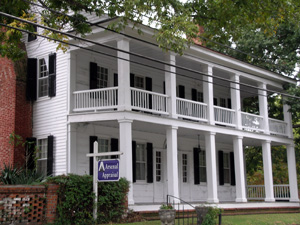
Cool Spring Place, also known as Cool Spring Tavern, is a historic home located at Fayetteville, Cumberland County, North Carolina. It was built in 1788, and is a two-story, five bay by four bay, rectangular Federal-style frame dwelling. It low hipped roof and features a double porch on the front facade. It operated as a tavern until 1795, and is believed to be the oldest existing structure in the city of Fayetteville, having survived the disastrous fire of 1831.
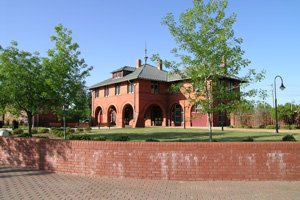
Cape Fear and Yadkin Valley Railway Passenger Depot is a historic train station located at 325 Franklin Street in Fayetteville, North Carolina. It was built in 1890 by the Cape Fear and Yadkin Valley Railway. It is a two-story brick passenger depot with a deep hip roof in the Romanesque Revival style. The seven bay by two bay building features a rounded brick arch arcade. It was listed on the National Register of Historic Places in 1983.

Fayetteville Downtown Historic District is a national historic district located in Fayetteville, Cumberland County, North Carolina. It encompasses 113 contributing buildings, 3 contributing sites, 1 contributing structure, and 2 contributing objects in the central business district of Fayetteville. The district includes commercial buildings, government and civic buildings, railroad-related structures, residential dwellings, churches and the Cross Creek Cemetery. They range in build date from the 1780s to 1949. The district includes the previously listed Liberty Row and Market House Square District and 16 resources listed as part of the "Historic Resources of Fayetteville," a Multiple Resource Nomination.

Market House Square District is a national historic district located at Fayetteville, Cumberland County, North Carolina. It encompasses 11 contributing buildings in the central business district of Fayetteville. The district includes six storefronts and a major store, an office building, a former Knights of Pythias Building, and the First Citizen's Bank Building, all of which date between 1884 and 1926 and ring the separately listed Market House. The First Citizen's Bank Building was designed by architect Charles C. Hartmann and built in 1926.

Eagle Lodge is a historic Masonic lodge building located at Hillsborough, Orange County, North Carolina. It was built in 1823, and two-story, three-bay, square brick building in the Greek Revival style. Its brickwork is laid in Flemish bond. It has a low hipped roof with heavy box cornice and a one-story pedimented porch with Ionic order columns.
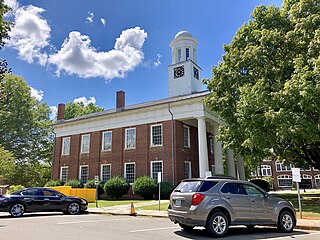
Old Orange County Courthouse is a historic courthouse building located at Hillsborough, Orange County, North Carolina. It was built in 1845, and is a two-story, Greek Revival-style, temple-form brick structure. It replaced Dickerson Chapel as the county's courthouse. The front facade features a Doric order tetrastyle pedimented portico and two-stage clock tower. The brickwork is laid in Flemish bond. The building served as the seat of Orange County's government until 1954, when a new building was completed.

Old Brick House is a historic home located at Elizabeth City, Pasquotank County, North Carolina. It was built about 1750, and is a 1+1⁄2-story frame dwelling with brick gable ends. It sits on a raised brick basement, has a gable roof with dormers, and two interior end chimneys with molded caps. The interior features a richly carved mantel with an elaborate broken ogee pediment. It is one of the few brick-end buildings in the state. The brickwork is laid in Flemish bond with glazed headers. It is a member of the small group of 18th century frame houses with brick ends in northeast North Carolina; the group includes the Sutton-Newby House and the Myers-White House.
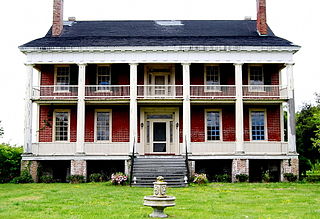
Land's End, also known as Leigh House, is a historic plantation house located near Hertford, Perquimans County, North Carolina. It was built about 1830, and is a two-story, five bay by four bay, Greek Revival-style brick dwelling. Its brickwork is laid in Flemish bond. It has a gable roof and features front and rear full-height porticoes supported by unfluted Doric order columns.

Sutton-Newby House is a historic plantation house located near Hertford, Perquimans County, North Carolina. It was built about 1745, and is a 1+1⁄2-story, four-bay, frame dwelling with a brick end and gable roof. It originally had both ends in brick. It features a full-width, shed roofed front porch and massive double-shouldered chimney. It is a member of the small group of 18th century frame houses with brick ends in northeast North Carolina; the group includes the Myers-White House and the Old Brick House. The Sutton–Newby House's brickwork is laid in Flemish bond.























